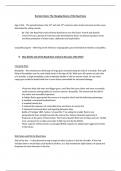Summary
Summary The Changing nature of the Royal Navy, revision notes
- Institution
- PEARSON (PEARSON)
In-depth notes on everything you need to know to full prepare you for the trade and navy part of the exam. Trade is a separate document and will need to be purchased separately but these are A* quality notes with everything you’ll ever need to know for the exam.
[Show more]




